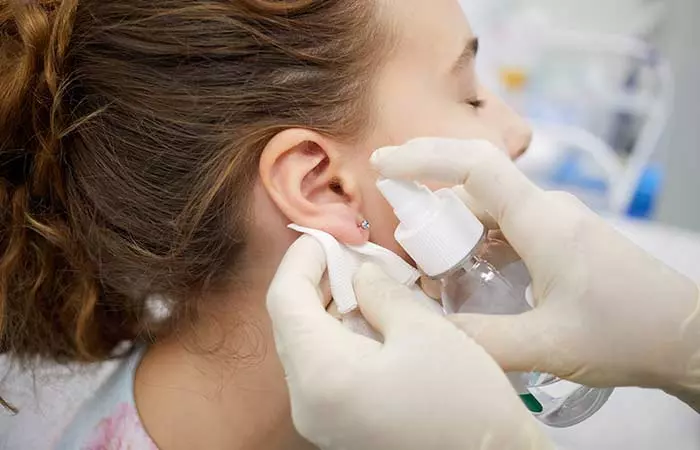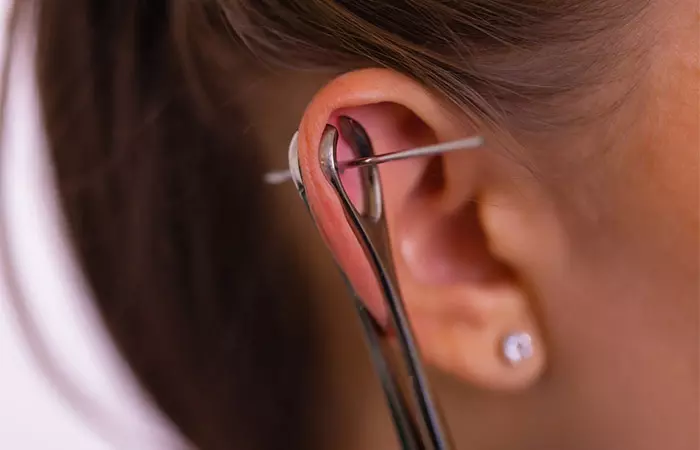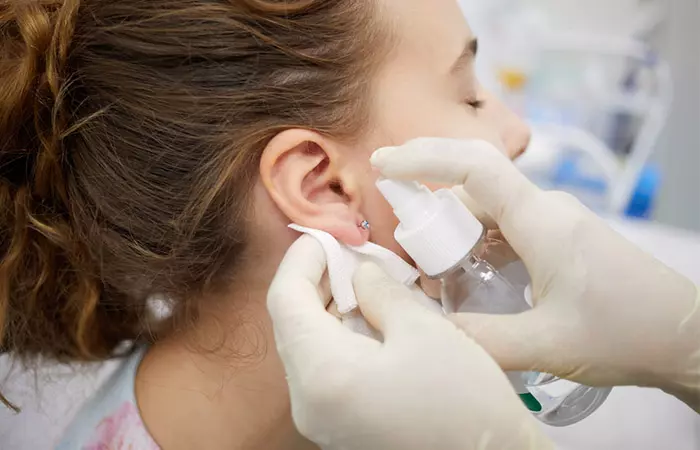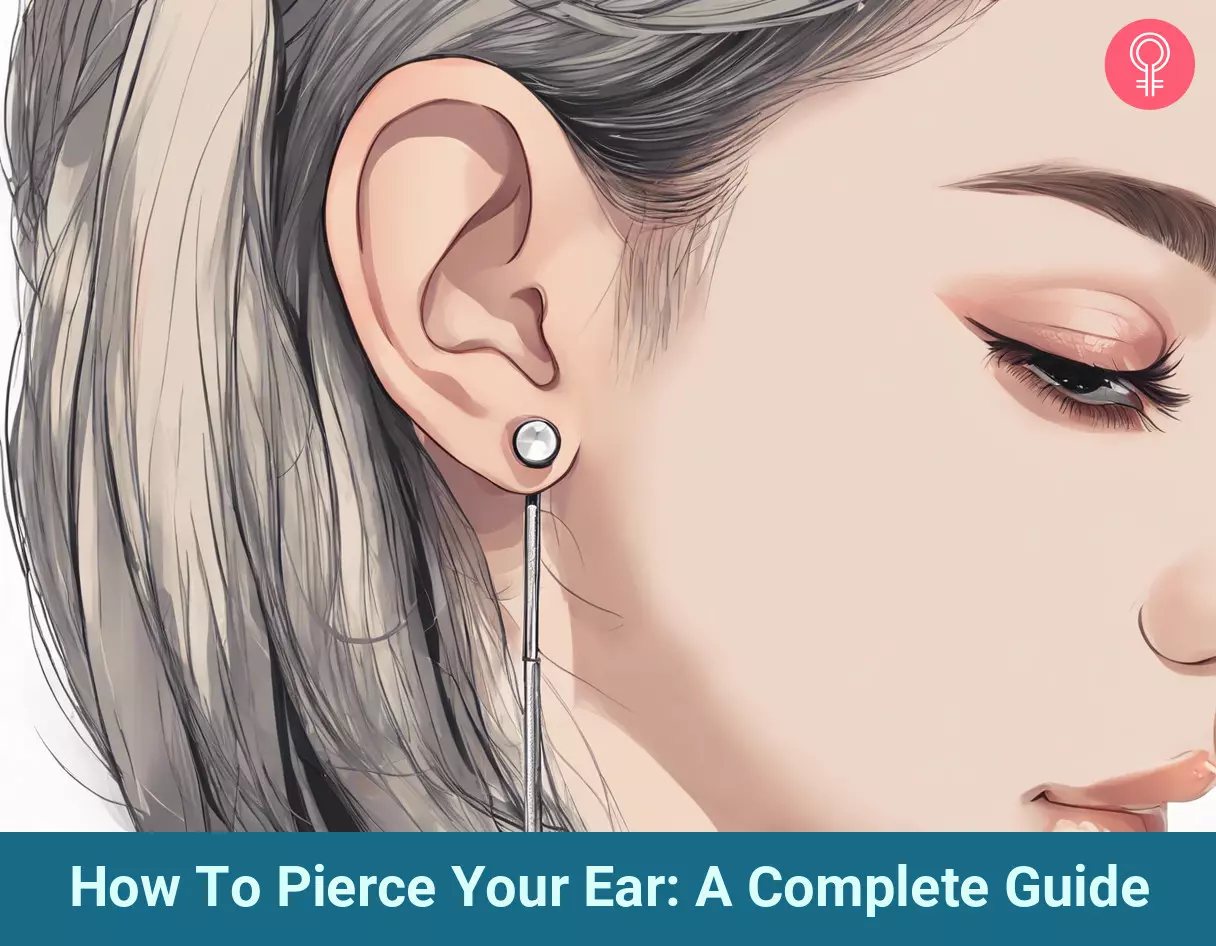Multiple ear piercings are on-trend; moreover, pierced ears are a creative and sophisticated way to express your personality. Fashion Stylist Michelle Wagman says, “Piercing typically refers to puncturing the skin or cartilage to insert jewelry. It is a common form of body modification and can be performed on various body parts, such as the ears, nose, tongue, and belly button.” Many of you must be looking for how to pierce your ear but did you know piercing your ears can be beneficial to stimulate the surrounding nerve areas too? It’s also breathtaking to notice that history has to do so much with piercing ears. Dating back to 5000 years ago, the primitive tribes performed it for their magical purposes. Every nation has its spiritual-religious reasons to pierce ears. Michelle Wagman also adds, “Piercings can be purely decorative or have cultural or religious significance.” If you already have piercings or are considering them but lack the necessary information for it, you are in the right place! So, without further ado, check out how to pierce your own ear.
How To Pierce Your Ear Safely At Home?
Earrings are on top of the jewelry list when it comes to fashion, and piercing ears with more than one hole have become chic à la mode. There are many ways to pierce your ears without getting them infected. Visiting an expert or a doctor can be tiring; therefore, DIY piercing becomes much easier. Of course, while doing it at home, higher precautions must be taken into consideration. So, you must do some homework on how to pierce your own ear because later, your chances of rushing to the doctor will be way too low. Check out these tips on how to safely pierce your ears at home.
Cleaning The Bacteria: Wash your hands or wear gloves and thoroughly wipe the area that you will pierce either by rubbing alcohol or 70 percent pre-packaged isopropyl alcohol swabs and let your ears dry entirely. This will help in not allowing the dirt of the outer layer to go inside. Choosing The Needle: Always go for steel sterilized needles for piercing. Pick the needle that is one gauge bigger than the earrings you will wear; only then will the hollow center of the sterile piercing needle allow your earrings to fit right into the hole easily. With the support of an open flame, sterilize the needle until the tip turns super orangey-red. Always go for piercing earrings at first; later, you can switch to your collections. Remember, always make a mark and tie your hair up before compressing the needle. After all the preparations are done, take a small, sturdy wooden or metal and compress it against your ears, this will let the needle pass through your ears smoothly. Taking Care Of The Piercing: Try not to remove the piercings for a month and so. Piercings take nearly a year to get their shape correctly. Between this course of time, clean your piercings, remove the earrings and change them from time to time.
Putting the needle on should be done as soon as possible to avoid a natural inflammatory response.
How Does Ear Piercing Work?
Whether you want to have lobe, helix, rook, daith, tragus, antitragus piercings, flat or conch piercing, there are two main ways to do it: through the gun or the needle. Piercing your ears is an easy process, where the needle takes a minute, and the gun slides down within a few seconds. In the case of needle piercing, the piercer chooses a hollow sterilized needle to provide the safest experience. The needle basically works like a bistoury by cutting through the skin to insert it on the other side of the ear. Moreover, don’t stress about placing the earrings after the piercing is done because the needle’s hollow space will do the magic. The earrings will get inside your ears like butter. In the case of a gun, it will shoot a loop to your earlobe. It is the stem of the jewel that pierces the skin. Then the buckle is positioned on the backside of the ear hole. For some people, the gun seems to be loud and quite traumatic, whereas the needle is more painful and uncomfortably tingling. Everyone can choose one according to their preferences. These two techniques can be used for piercing ears at home or any professional place. You should consider the benefits of having a professional handle the process before you decide to pierce your own ears at home. Professional piercers are equipped with the right tools and training to ensure minimal pain and reduce the risk of infection or complications that can arise from improper techniques. Their expertise ensures a more accurate placement and cleaner procedure, contributing to faster healing and a better experience. But, until you have good experience and knowledge, don’t try them at home. However, an important point to note here is that sometimes you might be confused about how to know if your ear piercing is infected. This is a constant worry for anyone who pierces their ears, so here are some points on how to tell if your ear piercing is infected:
Crumbly discharge. Stinging sensation with pain and redness in the pierced area The earrings might get stuck as the skin might swell up. A burning sensation in the pierced area. Feeling unwell.
Once you pierce your ears, you should check for any signs of infection around the piercing site. Recognising these signs early on can prevent further complications from arising. If you notice any of these signs, consult a healthcare professional to avoid more severe infections or long-term issues. Continue reading for more information on how to carry out this procedure safely at home.
How To Safely Pierce Your Own Ears
Many of you must be wondering how to pierce your own ear without it hurting—so, confused about choosing which way will be the best? To avoid pain, infections, and allergies while piercing your ears, always disinfect the needle that you are gonna use, be it the gun or the needle. What is more, disinfecting the piercing earrings is also highly recommended. By understanding and knowing the process, you can choose to do it by yourself. And make sure that the process is carried out in a hygienic condition. Moreover, selecting a needle while doing it by yourself can be easier. And, below are some more valuable points to remember while learning how to pierce your ear by yourself before doing it. This is how you pierce your own ears to ensure maximum safety. However, it is good to learn about the risks involved in ear piercing. Check them out in the following section.
Risks Of Ear Piercing
Millions of people get their ears pierced each year, and it is a fairly safe and simple process. However, it is after all creating a hole in your body and comes with potential risks. The wound is susceptible to infections that can cause pain, discharge, and swelling. Some people can be allergic to the jewelry they wear or the piercing tool, which may lead to worsening of the wound. Other risks involve trauma, keloids, and blood-borne diseases in rare cases, such as hepatitis B and C. Nonetheless, much of the risk can be minimized with proper care. Move to the next section to learn more about it.
How To Take Care Of Your Pierced Ears
Did you know that pretty pieces of jewelry require so many responsibilities? Although piercing ears are more common and less risky, if the pierced areas are correctly handled, then complications might occur. Now that you are done with your ear piercings, it’s time to take some aftercare of the pierced area. Michelle Wagman adds, “Caring for a new piercing is essential to prevent infection and promote healing.” If you’re wondering how to clean your ears after piercing, don’t worry. I got your back again. Here are some tips on how to clean your ear-piercing. This is another must-read, so go on!
Wash And Disinfect Your Hands: Always clean your hands. Don’t touch the piercings with dirty hands. Don’t Keep Opening The Starter Earrings: It will create severe pain, and also it might lead to the closing of the hole. Rotate The Earrings Daily: This will prevent tightening the hole or getting the piercings close. Dab Some Rubbing Alcohol: Do not press hard or rub the alcohol; just dab a little to disinfect. Switch Sides: Don’t press the piercing area for too long. Switch sides while sleeping. Keep An Eye On Abnormal Discharge: Unusual discharge can be a sign of infection, so immediately see a doctor if noticed. Keep The Externals Away: Remove external elements out of the piercing area. Don’t let your hair contact the pierced area. Avoid Any Soap: Clean the area with antiseptic items instead.
Body modification has become a popular way to express oneself. Ear piercing is one of the most popular types of body modification that can be done at home. However, it’s highly recommended that you get it done by a professional piercer for safety reasons. Following proper aftercare practices like regular cleaning and maintaining the piercings helps you to avoid infections and scarring. However, infections might occur in a healed piercing area too. To prevent that, choosing the perfect size of piercing earrings is essential. If you see any complications, then proper treatment can help in treating the infections. Moreover, wait until you’re healed adequately after putting on the starter earrings. Cleanse the piercing using a mild antiseptic lotion. Disinfect twice a day for about three weeks, then adopt a more prolonged interval until complete healing. Can I use a sewing needle to pierce? No, you should not pierce your body parts with a sewing needle due to the higher risk of skin infection. Can you get paralyzed from piercing your ear? No, the act of piercing your ear does not paralyze you. However, not cleaning the wound properly or piercing with a dirty needle can result in an infection. In rare cases, the infection may lead to paralysis. Do ear piercings bleed? Yes, ear piercing can bleed immediately after the procedure. If you notice pus oozing out with the blood, consult your doctor. Is gunshot ear piercing painful? Yes, gunshot ear piercing is painful. Piercing with a needle is considered a safer and less painful procedure than gunshot piercing. Learn how to pierce your ears at home like a pro! Get step-by-step instructions and tips from this video to make the process safe and easy. Check it out!
Illustration: How To Pierce Your Ear: A Complete Guide












title: “How To Pierce Your Ear A Complete Guide” ShowToc: true date: “2024-09-20” author: “Mia Burns”
Multiple ear piercings are on-trend; moreover, pierced ears are a creative and sophisticated way to express your personality. Fashion Stylist Michelle Wagman says, “Piercing typically refers to puncturing the skin or cartilage to insert jewelry. It is a common form of body modification and can be performed on various body parts, such as the ears, nose, tongue, and belly button.” Many of you must be looking for how to pierce your ear but did you know piercing your ears can be beneficial to stimulate the surrounding nerve areas too? It’s also breathtaking to notice that history has to do so much with piercing ears. Dating back to 5000 years ago, the primitive tribes performed it for their magical purposes. Every nation has its spiritual-religious reasons to pierce ears. Michelle Wagman also adds, “Piercings can be purely decorative or have cultural or religious significance.” If you already have piercings or are considering them but lack the necessary information for it, you are in the right place! So, without further ado, check out how to pierce your own ear.
How To Pierce Your Ear Safely At Home?
Earrings are on top of the jewelry list when it comes to fashion, and piercing ears with more than one hole have become chic à la mode. There are many ways to pierce your ears without getting them infected. Visiting an expert or a doctor can be tiring; therefore, DIY piercing becomes much easier. Of course, while doing it at home, higher precautions must be taken into consideration. So, you must do some homework on how to pierce your own ear because later, your chances of rushing to the doctor will be way too low. Check out these tips on how to safely pierce your ears at home.
Cleaning The Bacteria: Wash your hands or wear gloves and thoroughly wipe the area that you will pierce either by rubbing alcohol or 70 percent pre-packaged isopropyl alcohol swabs and let your ears dry entirely. This will help in not allowing the dirt of the outer layer to go inside. Choosing The Needle: Always go for steel sterilized needles for piercing. Pick the needle that is one gauge bigger than the earrings you will wear; only then will the hollow center of the sterile piercing needle allow your earrings to fit right into the hole easily. With the support of an open flame, sterilize the needle until the tip turns super orangey-red. Always go for piercing earrings at first; later, you can switch to your collections. Remember, always make a mark and tie your hair up before compressing the needle. After all the preparations are done, take a small, sturdy wooden or metal and compress it against your ears, this will let the needle pass through your ears smoothly. Taking Care Of The Piercing: Try not to remove the piercings for a month and so. Piercings take nearly a year to get their shape correctly. Between this course of time, clean your piercings, remove the earrings and change them from time to time.
Putting the needle on should be done as soon as possible to avoid a natural inflammatory response.
How Does Ear Piercing Work?
Whether you want to have lobe, helix, rook, daith, tragus, antitragus piercings, flat or conch piercing, there are two main ways to do it: through the gun or the needle. Piercing your ears is an easy process, where the needle takes a minute, and the gun slides down within a few seconds. In the case of needle piercing, the piercer chooses a hollow sterilized needle to provide the safest experience. The needle basically works like a bistoury by cutting through the skin to insert it on the other side of the ear. Moreover, don’t stress about placing the earrings after the piercing is done because the needle’s hollow space will do the magic. The earrings will get inside your ears like butter. In the case of a gun, it will shoot a loop to your earlobe. It is the stem of the jewel that pierces the skin. Then the buckle is positioned on the backside of the ear hole. For some people, the gun seems to be loud and quite traumatic, whereas the needle is more painful and uncomfortably tingling. Everyone can choose one according to their preferences. These two techniques can be used for piercing ears at home or any professional place. You should consider the benefits of having a professional handle the process before you decide to pierce your own ears at home. Professional piercers are equipped with the right tools and training to ensure minimal pain and reduce the risk of infection or complications that can arise from improper techniques. Their expertise ensures a more accurate placement and cleaner procedure, contributing to faster healing and a better experience. But, until you have good experience and knowledge, don’t try them at home. However, an important point to note here is that sometimes you might be confused about how to know if your ear piercing is infected. This is a constant worry for anyone who pierces their ears, so here are some points on how to tell if your ear piercing is infected:
Crumbly discharge. Stinging sensation with pain and redness in the pierced area The earrings might get stuck as the skin might swell up. A burning sensation in the pierced area. Feeling unwell.
Once you pierce your ears, you should check for any signs of infection around the piercing site. Recognising these signs early on can prevent further complications from arising. If you notice any of these signs, consult a healthcare professional to avoid more severe infections or long-term issues. Continue reading for more information on how to carry out this procedure safely at home.
How To Safely Pierce Your Own Ears
Many of you must be wondering how to pierce your own ear without it hurting—so, confused about choosing which way will be the best? To avoid pain, infections, and allergies while piercing your ears, always disinfect the needle that you are gonna use, be it the gun or the needle. What is more, disinfecting the piercing earrings is also highly recommended. By understanding and knowing the process, you can choose to do it by yourself. And make sure that the process is carried out in a hygienic condition. Moreover, selecting a needle while doing it by yourself can be easier. And, below are some more valuable points to remember while learning how to pierce your ear by yourself before doing it. This is how you pierce your own ears to ensure maximum safety. However, it is good to learn about the risks involved in ear piercing. Check them out in the following section.
Risks Of Ear Piercing
Millions of people get their ears pierced each year, and it is a fairly safe and simple process. However, it is after all creating a hole in your body and comes with potential risks. The wound is susceptible to infections that can cause pain, discharge, and swelling. Some people can be allergic to the jewelry they wear or the piercing tool, which may lead to worsening of the wound. Other risks involve trauma, keloids, and blood-borne diseases in rare cases, such as hepatitis B and C. Nonetheless, much of the risk can be minimized with proper care. Move to the next section to learn more about it.
How To Take Care Of Your Pierced Ears
Did you know that pretty pieces of jewelry require so many responsibilities? Although piercing ears are more common and less risky, if the pierced areas are correctly handled, then complications might occur. Now that you are done with your ear piercings, it’s time to take some aftercare of the pierced area. Michelle Wagman adds, “Caring for a new piercing is essential to prevent infection and promote healing.” If you’re wondering how to clean your ears after piercing, don’t worry. I got your back again. Here are some tips on how to clean your ear-piercing. This is another must-read, so go on!
Wash And Disinfect Your Hands: Always clean your hands. Don’t touch the piercings with dirty hands. Don’t Keep Opening The Starter Earrings: It will create severe pain, and also it might lead to the closing of the hole. Rotate The Earrings Daily: This will prevent tightening the hole or getting the piercings close. Dab Some Rubbing Alcohol: Do not press hard or rub the alcohol; just dab a little to disinfect. Switch Sides: Don’t press the piercing area for too long. Switch sides while sleeping. Keep An Eye On Abnormal Discharge: Unusual discharge can be a sign of infection, so immediately see a doctor if noticed. Keep The Externals Away: Remove external elements out of the piercing area. Don’t let your hair contact the pierced area. Avoid Any Soap: Clean the area with antiseptic items instead.
Body modification has become a popular way to express oneself. Ear piercing is one of the most popular types of body modification that can be done at home. However, it’s highly recommended that you get it done by a professional piercer for safety reasons. Following proper aftercare practices like regular cleaning and maintaining the piercings helps you to avoid infections and scarring. However, infections might occur in a healed piercing area too. To prevent that, choosing the perfect size of piercing earrings is essential. If you see any complications, then proper treatment can help in treating the infections. Moreover, wait until you’re healed adequately after putting on the starter earrings. Cleanse the piercing using a mild antiseptic lotion. Disinfect twice a day for about three weeks, then adopt a more prolonged interval until complete healing. Can I use a sewing needle to pierce? No, you should not pierce your body parts with a sewing needle due to the higher risk of skin infection. Can you get paralyzed from piercing your ear? No, the act of piercing your ear does not paralyze you. However, not cleaning the wound properly or piercing with a dirty needle can result in an infection. In rare cases, the infection may lead to paralysis. Do ear piercings bleed? Yes, ear piercing can bleed immediately after the procedure. If you notice pus oozing out with the blood, consult your doctor. Is gunshot ear piercing painful? Yes, gunshot ear piercing is painful. Piercing with a needle is considered a safer and less painful procedure than gunshot piercing. Learn how to pierce your ears at home like a pro! Get step-by-step instructions and tips from this video to make the process safe and easy. Check it out!
Illustration: How To Pierce Your Ear: A Complete Guide











